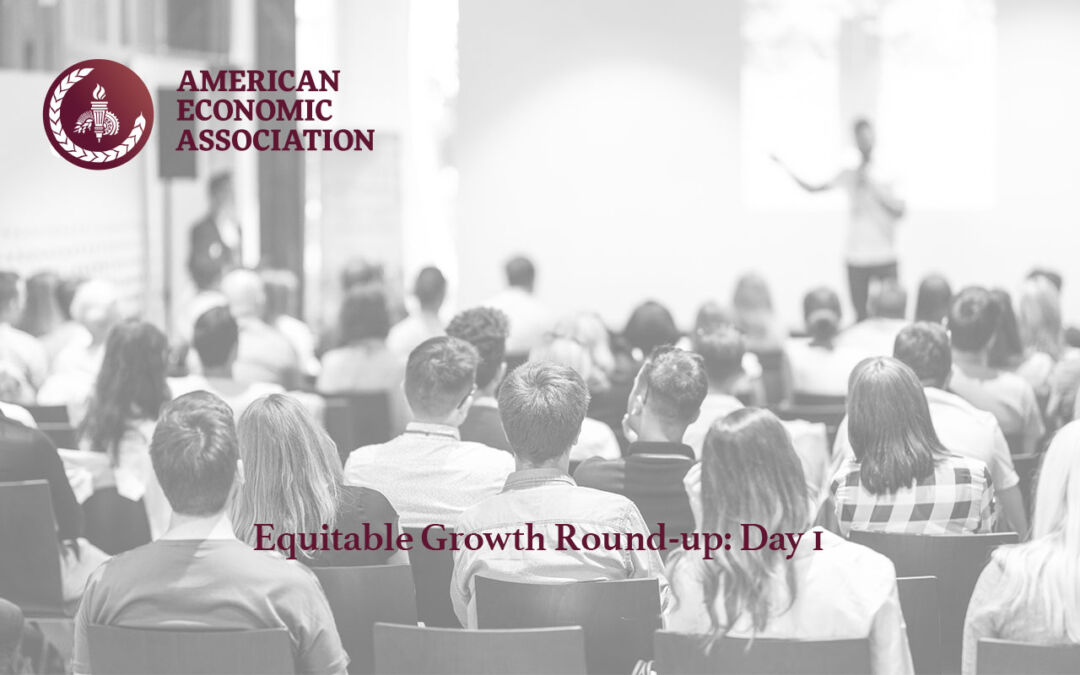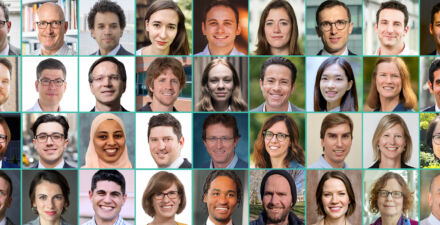ASSA 2024 Round-up: Day 1

Yesterday was the first day of the 2024 annual meeting of the Allied Social Science Associations, which is organized by the American Economic Association. The 3-day conference, held in person in San Antonio, Texas, this year, features hundreds of sessions covering a wide variety of economics and other social science research. This year, Equitable Growth’s grantee network, Steering Committee, and Research Advisory Board and their research are well-represented throughout the program, featured in almost 60 different sessions of the conference.
Below are lightly edited abstracts from some of the papers and presentations that caught the attention of Equitable Growth staff during the first day of this year’s conference and which relate to the research interests laid out in our current Request for Proposals for early career scholars. We also include links to the sessions in which the papers were presented.
Come back tomorrow morning for more highlights from day two, and Monday morning for highlights from day three.
“The Class Gap in Career Progression: Evidence from Academia”
Anna Stansbury, Massachusetts Institute of Technology, Equitable Growth grantee; Kyra Rodriguez, Massachusetts Institute of Technology
Abstract: It is well-documented that women and people of color face disproportionate barriers to academic advancement. However, socioeconomic status is often overlooked. Little is known about whether or how academic careers differ by socioeconomic background. Recent work by Morgan and co-authors (2022) documents how tenure-track academia in the United States is starkly less socioeconomically diverse than the U.S. population. Schultz and Stansbury (2022) further find disciplinary differences, wherein economics, mathematics, and computer science Ph.Ds. in the United States have smaller shares of first-generation college students (no parent with a bachelor’s degree) than other disciplines. Our paper builds upon this limited literature to systematically document key stylized facts at important points in academia’s tenure-track pathway, from the undergraduate level to tenure. We use the National Science Foundation’s Survey of Earned Doctorates and Survey of Doctorate Recipients to trace individuals from their undergraduate degree, throughout their careers, and across a rich set of career outcomes. We find that academic careers are characterized by two phenomena for lower-socioeconomic status doctorates: the leaky pipeline and the slippery ladder. The leaky pipeline metaphor, borrowed from the literature on gender in academia, illustrates that at each step of the academic career after the Ph.D., people from lower socioeconomic status backgrounds are more likely to leave academia. The slippery ladder metaphor is used to describe our finding that at each step in the academic career, people from lower socioeconomic status backgrounds who stay in academia are in lower-ranked institutions. Both phenomena are present even conditional on fixed effects for academic field and prior institutions, illustrating that socioeconomic status plays a role not just on entry to an undergraduate or Ph.D. program but also throughout the academic career trajectory. We further examine these phenomena by field and compare and combine our socioeconomic status results with gender and race. Finally, we explore several possible mechanisms.
“Income, Wealth, and Environmental Inequality in the United States”
Jonathan Colmer, University of Virginia, Equitable Growth grantee; Suvy Qin, University of California, Berkeley; John Voorheis, U.S. Census Bureau, Equitable Growth grantee; Reed Walker, University of California, Berkeley
Abstract: Environmental inequality is thought to be rooted in various aspects of economic inequality, and addressing the latter is believed to reduce the former. However, the relationship between environmental exposure and economic well-being is not well understood, as data on environmental exposure and economic well-being are typically unavailable at the same spatial resolution, and existing evidence on the relationships between income and environmental exposures is largely correlational. This paper aims to provide systematic evidence on the relationship between pollution exposure, income, wealth, and race by combining administrative data from tax returns between 1984–2019, remote sensing measurements of particulate exposure, and sociodemographic information from linked survey, census, and administrative data. We document new facts about the observational relationships between income, wealth, and particulate exposure at the individual level, showing how these relationships differ by race and have changed over time. We use quasi-random shocks to income to examine the causal effect of changes in income and wealth on pollution exposure. We find that racial disparities in pollution exposure are unlikely to be ameliorated by relative improvements in the distribution of income or wealth in the short and medium run.
“Unemployment Risk, Portfolio Choice, and the Racial Wealth Gap”
Chi Hyun Kim, University of Bonn; Ellora Derenoncourt, Princeton University, Equitable Growth grantee; Moritz Kuhn, University of Bonn; Moritz Schularick, University of Bonn
Abstract: Black Americans are exposed to strong cyclical unemployment risk that correlates with stock market returns. Under high exposure to cyclical unemployment risk, it is optimal for individuals to invest less in risky assets and minimize overall risk exposure over their life cycle. Our study shows that cyclical unemployment risk explains a substantial amount of the equity gap across Black and White Americans during 1980–2020: 20 percent of the stock market participation gap and 50 percent of the gap in Black and White equity shares in portfolios. Given continuously rising equity returns, such frictions in the labor market will further perpetuate racial wealth inequality in the United States.
“The Legacy of Lynchings and State-Sanctioned Violence Against Black Americans ”
Jhacova Williams, American University
Abstract: We analyze the extent to which race-specific police-related fatalities are linked to historical lynchings that took place from 1851 to 1930. We show that Black, White, and other racial minorities who reside in counties that experienced a higher number of historical lynchings also face higher levels of police violence today. This relationship holds after accounting for a variety of historical and contemporary characteristics of counties, including arrest rates and homicides. Our results are strongest for Black individuals, which provides evidence of continued violence perpetrated against Black individuals that date back more than 140 years. Additionally, we find that not only are Black lynchings related to contemporary police-related fatalities of Black individuals, but White lynchings and the lynchings of other racial minorities are also linked to police killings of Black individuals today. These results suggest that there has never been a moment in which Black people have been the primary target of state-sanctioned violence in the United States.
“New Evidence on Employee Noncompete, No Poach, and No Hire Agreements in the Franchise Sector ”
Peter Norlander, Loyola University-Chicago, Equitable Growth grantee
Abstract: This paper presents new evidence about the prevalence, source, scope, content, and variety of anticompetitive behavior in the labor market. Drawing from a text corpus of 17,785 franchise disclosure filings, I find that 26 percent of filings from January 2011–August 2022 contained an employee noncompete clause that requires franchisees to bar employees from working for a competitor after leaving. Further, 44 percent contained a nonsolicitation clause barring recruitment between firms, and 25 percent contain a no hire clause. Using new open-source, replicable methods to classify unstructured text, this paper also publicly releases a document corpus, the software used to analyze the data, a knowledge base of rules to detect anticompetitive clauses, and an opensource machine learning classifier to detect no poach clauses. While prior evidence on anticompetitive practices largely draws from individual complaints, survey data, and limited hand-coded samples, this paper spotlights a large and representative sample of previously hidden inter-firm contracts that block employee mobility and describes tools that can automatically identify future unseen instances.
Note: This research was funded in part by Equitable Growth.
“Workers and the Green-Energy Transition: Evidence from 300 Million Job Transitions”
Mark Curtis, Wake Forest University, Equitable Growth grantee; Layla O’Kane, Lightcast; R. Jisung Park, University of Pennsylvania, Equitable Growth grantee
Abstract: Using micro-data representing more than 130 million online work profiles, we explore job transitions into and out of jobs most likely to be affected by a transition away from carbon-intensive production technologies. Exploiting detailed textual data on job title, firm name, occupation, and industry to focus on workers employed in carbon-intensive (“dirty”) and non-carbon-intensive (“green”) jobs, we find that the proportion of workers who successfully transition from dirty jobs to green jobs is rising rapidly, increasing ten-fold over the period 2005–2021. Overall, however, fewer than 1 percent of all workers who ever held a dirty job appear to transition to a green job. We find that the persistence of employment within dirty industries varies enormously across local labor markets; in some states, more than half of all transitions out of dirty jobs are into other dirty jobs. Older workers and those without a college education appear less likely to make transitions to green jobs and more likely to transition to other dirty jobs. When accounting for the fact that green jobs tend to have later start dates, it appears that green jobs and dirty jobs have roughly comparable job durations (within 3 months).
“The Intergenerational Transmission of Employers and the Earnings of Young Workers”
Matthew Staiger, Opportunity Insights, Equitable Growth grantee and former Dissertation Scholar
Abstract: To what extent do connections in the labor market shape intergenerational mobility? I use employer-employee linked data to study one important type of connection: jobs obtained at a parent’s employer. Twenty-nine percent of individuals work for a parent’s employer at least once by age 30. Exploiting transitory and idiosyncratic variation in the availability of jobs at the parent’s employer, I estimate that working for a parent’s employer increases initial earnings by 19 percent. The results are attributable to parents using their connections to provide access to higher-paying firms. Individuals with higher-earning parents are more likely to work for a parent’s employer and experience larger earnings gains when they do. Consequently, the elasticity of initial earnings with respect to parental earnings would be 7.2 percent lower if no one found a job through these connections. The findings raise the possibility that connections to firms through one’s social network could be an important determinant of intergenerational mobility.
Note: This research was funded in part by Equitable Growth.
“COBOLing Together UI Benefits: How Delays in Fiscal Stabilizers Impact Aggregate Consumption”
Michael A. Navarrete, University of Maryland, Equitable Growth grantee
Abstract: The United States experienced an unprecedented increase in Unemployment Insurance claims starting in March 2020, mainly due to layoffs caused by COVID-19. State Unemployment Insurance systems were inadequately prepared to process these claims. Those states using an antiquated programming language, COBOL, to process UI claims experienced an increase in administrative burdens for potential claimants, which led to longer delays in benefit disbursement and an increase in discouraged filers. Using daily card consumption data from Affinity Solutions, I employ a two-way fixed effects estimator to estimate the causal impact of having an antiquated UI benefit system on aggregate consumption. The antiquated UI systems caused a 3.6 percentage point relative decline in total card consumption in COBOL states relative to non-COBOL states. This effect can be decomposed into three types: (1) delays in a claimant filing a claim, (2) delays in a UI benefit system processing a claim, and (3) an increase in discouraged filers. I find a 1.5 percentage point increase in the share of claims that experienced a processing delay over 70 days in COBOL states, relative to non-COBOL states. I also find suggestive evidence that the increase in administrative burdens for claimants in COBOL states led to an additional 5.6 million discouraged filers relative to non-COBOL states. These discouraged filers would have claimed UI benefits in COBOL states if the administrative burdens in their COBOL states had been as low as in non-COBOL states. Performing a back-of-the-envelope calculation using 2019 data, I find that a 3.6 percentage point decline in consumption in COBOL states in 2020 after the emergency declaration corresponds to a real Gross Domestic Product decline of $220 billion (in 2012 dollars).
“The Dynamics of Large Inflation Surges”
Andrés Blanco, University of Michigan, Equitable Growth grantee; Pablo Ottonello, University of Michigan; Tereza Ranosova, University of Michigan
Abstract: We empirically characterize episodes of large inflation surges that have been observed worldwide in the past three decades. We document four facts. (1) Inflation surges tend to be persistent, with the duration of disinflation exceeding that of the initial inflation increase. (2) Surges are initially unexpected but followed by a gradual catch-up of average short-term expectations with realized inflation. (3) Long-term inflation expectations tend to exhibit increases that persist throughout disinflation. (4) Policy responses are characterized by hikes in nominal interest rates but no tightening of real rates or fiscal balances. In sum, episodes of large and persistent inflation tend to occur with government responses that depart from the prescriptions of textbook policy rules and which instead are consistent with “fear of tightening.”
“Race, Jobs, Automation and the Post-COVID-19 Future of Work in America”
Kristen Broady, Federal Reserve Bank of Chicago; Anthony Barr, National Bankers Association; Aisha Meeks, Morehouse College; Ryan Perry, Federal Reserve Bank of Chicago
Abstract: The COVID-19 pandemic has accelerated trends in automation as many employers seek to save on labor costs amid widespread illness, increased worker leverage, and market pressures to onshore supply chains. While existing research has explored how automation may displace nonspecialized jobs, there is typically less attention paid to how this displacement may interact with preexisting structural issues around gender and racial inequality. This analysis updates that of a 2021 Brookings paper by the authors, finding that Black and Hispanic workers continue to be overrepresented in the 30 occupations with the highest estimated risk of automation and underrepresented in the 30 occupations with the lowest estimated risk of automation. The updated analysis also includes new attention to automation’s impact on women workers, wage structures, a consideration of the broader implications of automation for global economics, and a discussion of the potential interplay of automation with recent developments in artificial intelligence.



